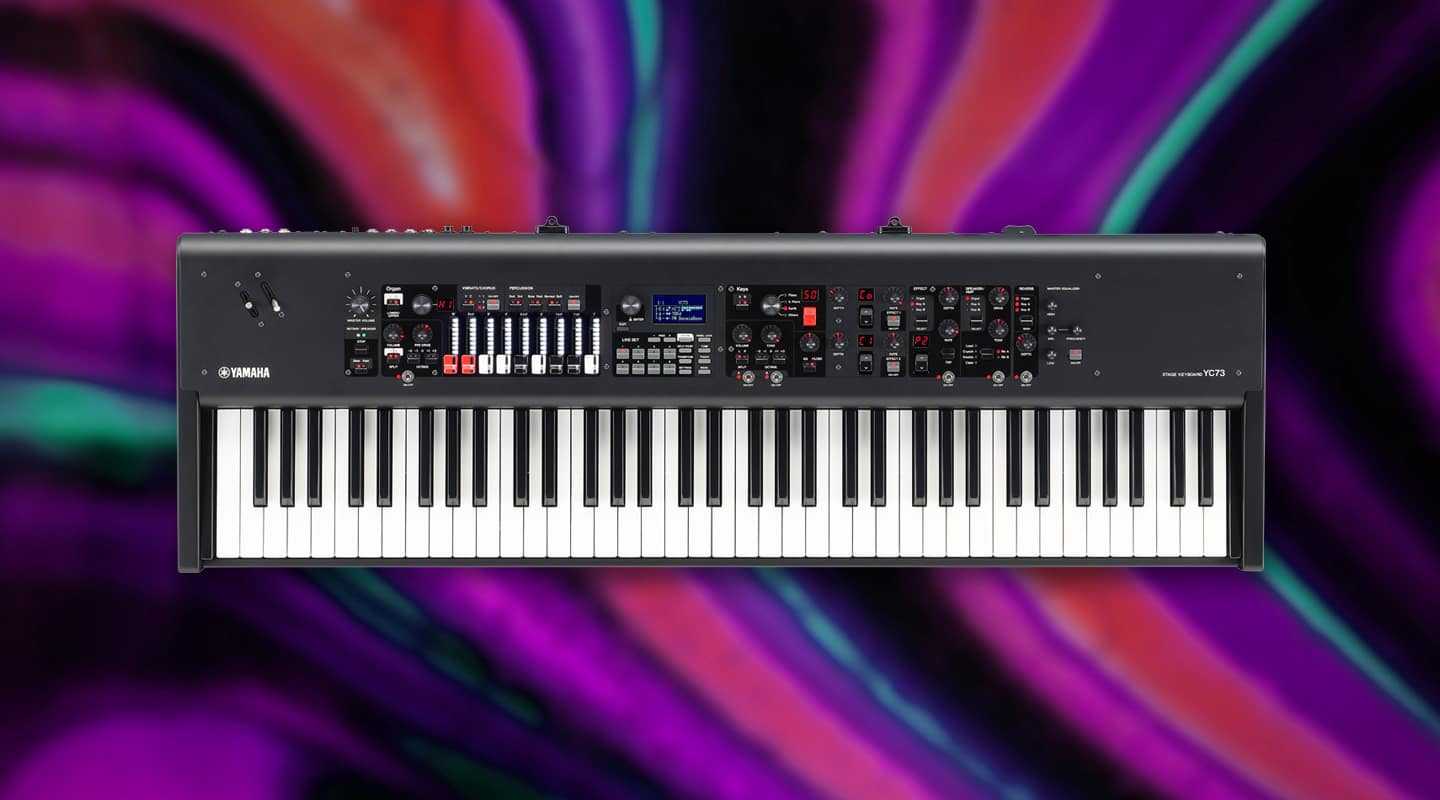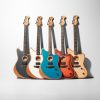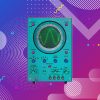
Review: Yamaha YC Series YC73
Yamaha launches a series of stage pianos that can’t be ‘ig-nord’.
“It’s a black Nord!” That was my first thought when I saw an advertisement for Yamaha’s new YC Series stage pianos.
“About time!” was the thought that immediately followed.
I’ve played endless models of stage pianos over the years and have always held a reverence for Yamaha’s offerings. A pedigree in manufacturing $100k+ grand pianos found in the world’s greatest concert halls speaks for itself, and I appreciate the company’s uncompromising recreations of the acoustic piano experience in its digital pianos. No wonder Yamaha enjoyed huge success when this market first broke out, starting with the CP Series in the 1970s.
However, in recent decades it would seem Yamaha has ceded territory to competing brands in the hotly contested stage piano market. In particular, Nord’s Stage and Electro keyboards became something like a de facto standard; they redefined the stage piano by proving big sound and deep functionality can be intuitive and tactile rather than buried in menus. Suddenly black keyboards were transposed for red ones across the globe and the Yamaha faithful were left wondering when the Japanese would give the Swedes a run for their krona.
A NORD-Y DUEL
Better late than never. Among a handful of formidable new stage piano releases from Yamaha is the YC Series, which I couldn’t help but notice bears more than a passing resemblance to the Nord family of products.
Three models comprise the YC lineup: the 61-note YC61 with waterfall action keybed, 73-note YC73 with balanced EP action, and 88-note YC88 with a triple sensor wood keybed. If that’s not similar enough to the trio of Nord Stage 3 models, just look at the panel layout: organ section with drawbars on the left, piano and synths section in the middle, and effects on the right. Aesthetically speaking, it’s a clear rivalry.
Yamaha Music Australia sent AudioTechnology the mid-sibling YC73 model to review. Coincidentally, I own a Nord Stage 3 Compact which is identical in size to the YC73, creating the perfect conditions for a comparison. Disclaimer: this is entirely in acknowledgment of the similarities between the two keyboards, not in ignorance of the fact the Nord is nearly $2k dearer than the Yamaha.
Finding the right stage piano is a very personal decision, especially if you’re after a gigging companion. Rather than try and cover every nitty gritty aspect, I’ll attempt to give you my overall impressions of the YC73 with the slant of being a Nord owner.
NEED TO KNOW
Yamaha YC Series YC73
Stage Piano
FROM THE TOP
First, a quick overview:
The meat and potatoes of the Yamaha YC73 comes in two parts – the Organ section and the Keys section. Both can be individually switched on and off. You’ll notice there are two switches in the Keys section – Keys A and Keys B – because Yamaha has duplicated this engine to allow for more layering and splitting options.
The Keys section of the YC73 is comprised of four libraries: Piano, E. Piano, Synth and Others (sample-based sounds). Both Keys A and Keys B can run simultaneously and are fully independent of each other. The A/B button at the top toggles the physical controls to match the layer you’re working on.
Yamaha has taken an interesting route with effects. Two effects processors live within the Keys engine, which is doubled to four when you count both Keys A and Keys B layers. That means you can run, for example, Keys A as a Piano with both reverb and compression, then simultaneously dial up a Rhodes with its own chorus and delay on Keys B. The list of 34 effects is fairly exhaustive, with distortions, compressors, a ring modulator, phaser, auto-wah, tremolos and more, creating a rather vast sonic universe within the Keys realm alone.
Then to the right is another Effects section which can be applied to a single engine – Organ, Keys A or Keys B. Next is a Speaker/Amp simulator which also treats a single engine at a time. The Reverb engine can apply globally to all sections or, like the Effects and Speaker/Amp Sim, can apply to a single section. With all the effects processors, a small numeric LCD display next to the red or black rocker switches gives a vague idea of what effect you’re on (h1, c3, etc.). It’s a little cryptic so thankfully a more detailed readout of what effect you’re controlling at the time also appears on the central screen.
Finally, a three-band EQ with sweepable mid frequency acts on the master output and is a great broad-brush corrective tool to optimise the YC73’s sound for different PAs and rooms.

KEYS PLEASE
As I expected, the Piano sounds are stunning. Modelled off Yamaha’s CFX, S700 and C7 grand pianos, there’s plenty of tonal breadth here to handle a delicate classical recital or powerful pop banger. Additionally, there’s a U1 upright and a couple of throwback CP80 voices. Cycle through piano models with the red up/down switch while the screen displays the selected option. The Tone knob lets you quickly fine tune the character of the sound from dull to brilliant and is a great way of perfecting a piano sound for a particular mood or PA system. This knob applies to all tones in the Keys section. I’m glad the Piano category has two dual-voice presets – piano/strings and piano/pads – which essentially give you more bang for buck if you’re trying to create multi-layered sounds with the Keys B engine and Organ.
My Nord’s 73 keys are a waterfall action organ keybed while the YC73 is a heavier balanced electric piano feel. The YC73’s action is a perfect middle ground for playing piano, synth and organ. While the keys aren’t the natural wood triple-sensor hammer action of the YC88, nothing felt ‘wrong’ about playing the beautiful acoustic and grand piano recreations on the YC73’s keybed.
EP & SYNTHS
Rotate the dial from Piano and you’ll meet the Electric Piano selection where Rhodes, Wurlitzers, Clavinet and nostalgic DX7 tones live. There’s a few variations of each and all are high quality, responsive sounds that are fun to play. Again, I appreciated having the Tone knob to quickly brighten up a dull Rhodes sound or mellow out a Clav. Having said that, I thought the electric pianos were less memorable than the YC73’s acoustic pianos, as far as realism goes.
The next twist of the knob takes you to Synths. There’s enough variety in here to cover most common synth sounds but the downside is the lack of manipulatable parameters which I have grown accustomed to on the Nord. A filter cutoff knob and envelope knob are the only real ‘synthesis’ controls you get, and sadly the dual purpose knob means only one of those things can be twiddled at once. There’s more than meets the eye, though. Eleven different envelope generator control ‘types’ are selectable in the menu, which dictates the knob’s function for a particular sound to cover anything from stabby percussive envelopes to slow and flowing pads. The same goes for the filter which has seven options to change the interplay between cutoff frequency and resonance. More settings like FM Unison, Portamento and Mono/Poly switch are also found in the menu. Nevertheless, the slim amount of control probably won’t satisfy if you relish the tone sculpting process. What would be a neat feature was if the mod stick was assignable to custom parameters the way Nord has the mod wheel ‘morph’ option.
Remember: the YC73 doesn’t have an independent synth engine like the Nord Stage keyboards, meaning it’s not designed for creating sounds from the ground up. If you’re after a synth sound, the best approach is to scroll the built-in presets, find one that’s close to what you’re looking for, then use the parameters at your disposal to tweak it to perfection. If that’s still not enough, buy a fully-fledged synth. Although to Yamaha’s credit, the presets offer a generous palette of synth flavours for a stage piano; big EDM chords, smooth monophonic analogue leads, funky basses, lush pads – they’re all here.
Seamless Sounds Switching keeps reverb tails and sustained chords hanging when you switch sounds to avoid the dreaded drop to silence during a performance


HANGING WITH THE OTHERS
The last stop on the Keys knob takes you to the Others library. All manner of sampled instruments are in here, such as stringed instruments, world instruments, brass and woodwind, accordions, bells, and more. Some are better than others. I was particularly impressed by the strings and horns options among others. It’s fun combining both Keys A and Keys B to layer sounds from this library and create texture-rich voices. In fact, the more time I spent with the YC73 the more I came to appreciate the presence of two Keys engines, as the majority of sounds I found myself creating were either layered or split mixtures of tones from them.
ORGAN
No one questions Yamaha’s competence when it comes to organs. I remember reviewing the baby Yamaha Reface YC organ years ago and having an absolute blast with it.
However, to execute an organ successfully within a stage piano requires some thought. The nine drawbars need to be tactile and natural within the relatively small space assigned to them on a multi-engine keyboard. And although one would expect a compromise when playing organ sounds on a weighted keybed like the YC73’s, it mustn’t feel so foreign that it becomes unplayable.
The YC73 executes its organ offering commendably. Six organ ‘types’ are available – three come from a new Virtual Circuitry Modeling (VCM) engine; and the other three are FM tone-generated organs. Six selections may sound paltry but there’s plenty of difference in character and harmonic content between them – including emulations of classics, of course – and when paired with the Pre-Drive control, you end up with a whole lot of organ tone potential. A notable absentee, however, are any church/pipe organs.
The physical drawbars are precise and fun to use. A strip of LEDs beside each one show a preset’s drawbar positions and changes colour according to upper or lower layer (with more customisable colour options in the Settings menu). When engaged, the Split button toggles through three options: Layer 1 on the bottom half; Layer 2 on the top half; or both at the same time. Leave the Split button off to play either Layer 1 or Layer 2 across the whole keyboard.
Any tonewheel organ recreation is incomplete without a Leslie cabinet emulation. You’ll find the YC73’s rotary speaker section ergonomically placed to the left of the organ section and it consists of a Stop button and Slow/Fast toggle. No complaints here; engage it for instant gospel vibes. The default acceleration/deceleration was a little slow for my liking and this is easily changed in the menu.
To further season your tone, the YC73 includes Vibrato/Chorus and Percussion options within the Organ section. Both have switchable options to fine tune the effects to your liking. Further settings for more detailed tweaks can be found in the settings menu, e.g. leakage level of the tonewheel and key click volume.
I thought the electric piano action of the YC73 slightly detracts from the organ playing experience. The waterfall action of the YC61 (which is much closer to what’s on the Nord Stage 3 Compact) is far better suited to sliding, rolling or chopping your way around a Hammond or Farfisa tone. Keep this in mind if, for you, organ takes priority over keys – the YC61 would promise a better experience.
ROAD COMPANION
Rugged and durable construction is an immediate marker of the YC series keyboards. Interacting with the controls feels anything but delicate. From the solid rotary knobs to the metal pitch and mod sticks to the sturdy drawbars and heavy duty toggle switches, the YC73 quickly won my confidence in its quality and reliability.
User presets are saved to what’s called a Live Set, which is the section of eight buttons under the screen for selecting a Live Set Sound. A Live Set Sound preserves a snapshot of every part of the YC73 for instant recall. There are 20 pages of these Live Sets, the first 10 of which are populated by the built-in presets. The latter 10 pages (or 80 Live Set Sound slots) are yours to fill. Live Set View displays the eight sounds on the current page. Seamless Sounds Switching keeps reverb tails and sustained chords hanging when you switch sounds to avoid the dreaded drop to silence during a performance. Changing and storing built-in presets to new pages is made efficient thanks to the dedicated Store button, and just as well because this is how I suspect a lot of people will build their catalogue of sounds on a YC keyboard. Navigating menus on the centre screen is equally efficient with the pushable rotary knob, as is setting the keyboard’s split point and global transpose.
BLACK IS BACK
Coming back to whether Yamaha has created a Nord-worthy rival – it’s worth remembering the YC Series models cost a lot less than their Nord Stage 3 equivalents, so to expect an identical feature set and the extensive nature of a Nord’s voice and control options is unreasonable.
With that being the case, the YC Series value proposition is strong. After getting to know the YC73 quite well and going between it and my Nord, I believe its strength lies in its stripped back nature. As a stage piano, anyone can sit down behind a YC keyboard and be thoroughly satisfied with the first or second preset they pull up, be it acoustic piano, electric piano, organ or synth. If not, the dashboard controls are perfect for enhancing a preset to obtain the right sound fast. Just don’t expect to spend hours twisting knobs, creating complex multi-voice layered patches, or perfecting arpeggiator settings like you might on a Nord Stage 3.
For under $3500, the Yamaha YC73 is a serious stage piano option for a church, school or performing arts centre. Equally appealing, is the YC73 for keyboardists who want a quality and physically tough keyboard to play gigs with. With a great range of sounds, intuitive user interface, and sufficient tonal flexibility to please most performing pianists, the YC73 is an excellent all rounder that again cements Yamaha’s place in the stage piano market.
























Thank you so much for reviewing the YC-73!!
I have been waiting months for just one decent blurb on the 73 key model specifically and your article did not disappoint
I am in the market for a stage piano and I am in between a Nord Electro 5 or 6 HP and the YC-73 or YC-88.
I love the feel of a Nord Hammer Action…any experience or advice when comparing the feel and differences of the keybeds in the YC-88 vs 73 vs Nord HP (or other)?
Thanks again!
Hi Zane, thanks for your comment. I haven’t compared the hammer action keybeds side by side although I doubt you’ll be disappointed with either. All the best. – Preshan
and that is the rub….SO MANY reviews, but very little on key BED reviews and comparisons. Sure, it’s hard to describe and receive that info, but the more comparisons are made, the easier for us to get a “feel” for the feel of the key bed. Also, Yamaha totally screwed up by not offering a 73 w/waterfall….shame on you Yamaha….shame.
And…. shame on them for not offering the full wood key bed of the 88 in the 73…..shame.